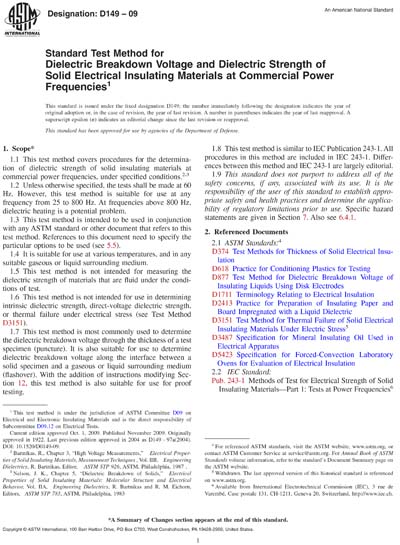Historical
ASTM D149-09
Standard Test Method for Dielectric Breakdown Voltage and Dielectric Strength of Solid Electrical Insulating Materials at Commercial Power Frequencies
1.1 This test method covers procedures for the determination of dielectric strength of solid insulating materials at commercial power frequencies, under specified conditions. ,
1.2 Unless otherwise specified, the tests shall be made at 60 Hz. However, this test method is suitable for use at any frequency from 25 to 800 Hz. At frequencies above 800 Hz, dielectric heating is a potential problem.
1.3 This test method is intended to be used in conjunction with any ASTM standard or other document that refers to this test method. References to this document need to specify the particular options to be used (see 5.5).
1.4 It is suitable for use at various temperatures, and in any suitable gaseous or liquid surrounding medium.
1.5 This test method is not intended for measuring the dielectric strength of materials that are fluid under the conditions of test.
1.6 This test method is not intended for use in determining intrinsic dielectric strength, direct-voltage dielectric strength, or thermal failure under electrical stress (see Test Method D3151).
1.7 This test method is most commonly used to determine the dielectric breakdown voltage through the thickness of a test specimen (puncture). It is also suitable for use to determine dielectric breakdown voltage along the interface between a solid specimen and a gaseous or liquid surrounding medium (flashover). With the addition of instructions modifying Section 12, this test method is also suitable for use for proof testing.
1.8 This test method is similar to IEC Publication 243-1. All procedures in this method are included in IEC 243-1. Differences between this method and IEC 243-1 are largely editorial.
1.9 This standard does not purport to address all of the safety concerns, if any, associated with its use. It is the responsibility of the user of this standard to establish appropriate safety and health practices and determine the applicability of regulatory limitations prior to use. Specific hazard statements are given in Section 7. Also see 6.4.1.
Content Provider
ASTM International [astm]






